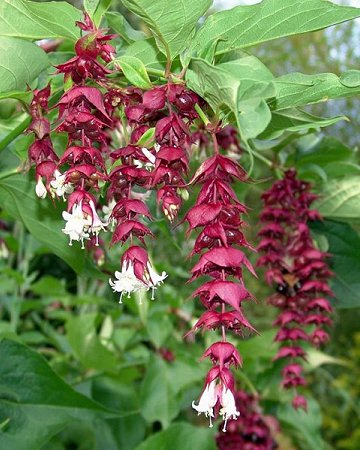
|
|
Himalayan Honeysuckle
(Leycesteria formosa). Flowers and fruits
|
Himalayan Honeysuckle - Leycesteria formosa
Leycesteria formosa (Himalayan Honeysuckle, Flowering Nutmeg, Himalaya Nutmeg or Pheasant
Berry) is a deciduous shrub in the family Caprifoliaceae, native to the Himalaya and southwestern
China. It is considered a noxious invasive species in Australia, New Zealand, the neighboring islands of
Macaronesia, and some other places. It is not yet considered a noxious invasive species in Canada or the United
States, but many plants with the common name
"Honeysuckle" are.
The plant was named by Nathaniel Wallich, director of the Calcutta Botanic Garden after his friend William
Leycester (1775-1831), a judge in the native court in Bengal, with formosa meaning
‘beautiful’, derived from the Latin. It has been in cultivation in the west since 1824.
Leycesteria formosa grows 8 feet (about 2.5 meters) tall. In its natural habitat, leycesteria grows in shaded forests and scrublands near creeks and
riverbeds. Seeds are dispersed both by water and by birds and animals that feed on the ripe
fruit. In areas where it is introduced, Himalayan honeysuckle can be highly
invasive.
It has soft, hollow, upright green stems, like canes, 1–2 m tall, which only last for 2–5 years before collapsing and being replaced by new stems from the
roots. The leaves are opposite, dark green, 6–18 cm long and 4–9 cm broad, with an entire or wavy
margin. The flowers are produced on 5–10 cm long pendulous racemes; each flower is
small, white, subtended by a purple bract. The flowers are hermaphrodite (have both male and female
organs) and are pollinated by Insects. It is noted for attracting wildlife.
The fragrant flowers bloom in spring and summer, and the fruits develop in mid to late
fall. The fruit is a soft purple-black berry 1 cm diameter, eaten by birds which disperse the
seeds.
The fruit is edible and taste like burnt
sugar. In the better forms, the fully ripe and very soft fruit is very sweet with a
treacle-like flavour, though in other forms it has a very bitter taste and is not very
desirable. Some cultivated lines have sweet, chocolate flavoured fruit, with others being bitter and
unpalatable. Its hollow stems have also been used to create wind instruments such as flutes and
whistles.
L. formosa became a popular plant in Victorian shrubberies. Attempts have been made in recent years to repopularise the species in Britain with new cultivated varieties appearing in garden
centres.
Leycesteria is a shrub that can withstand high wind areas and urban pollution, making it a good garden shrub for areas with difficult growing
conditions. When allowed to grow at will, the stalks create a thicket-like environment that attracts nesting
birds. The flowers attract butterflies, hummingbirds, and other beneficial pollinators to the
garden.
Source:
http://en.wikipedia.org/wiki/Leycesteria_formosa
http://www.pfaf.org/user/Plant.aspx?LatinName=Leycesteria+formosa
http://davisla.wordpress.com/2011/07/29/
plant-of-the-week-leycesteria-formosa/
http://www.wisegeek.com/what-is-leycesteria.htm
